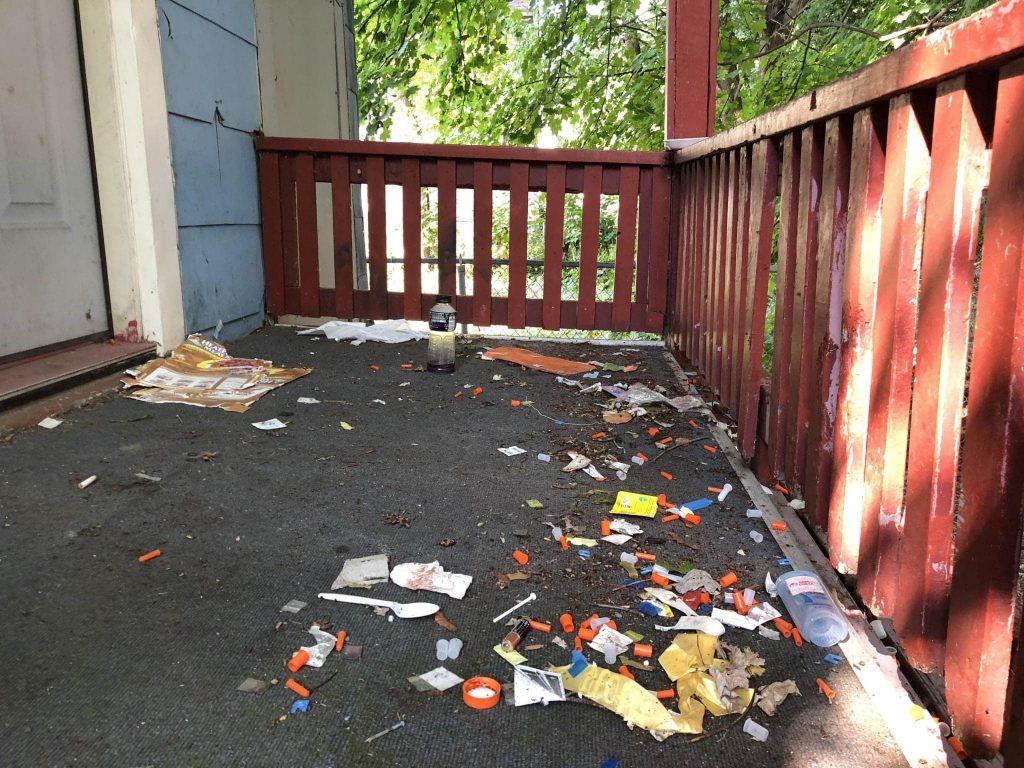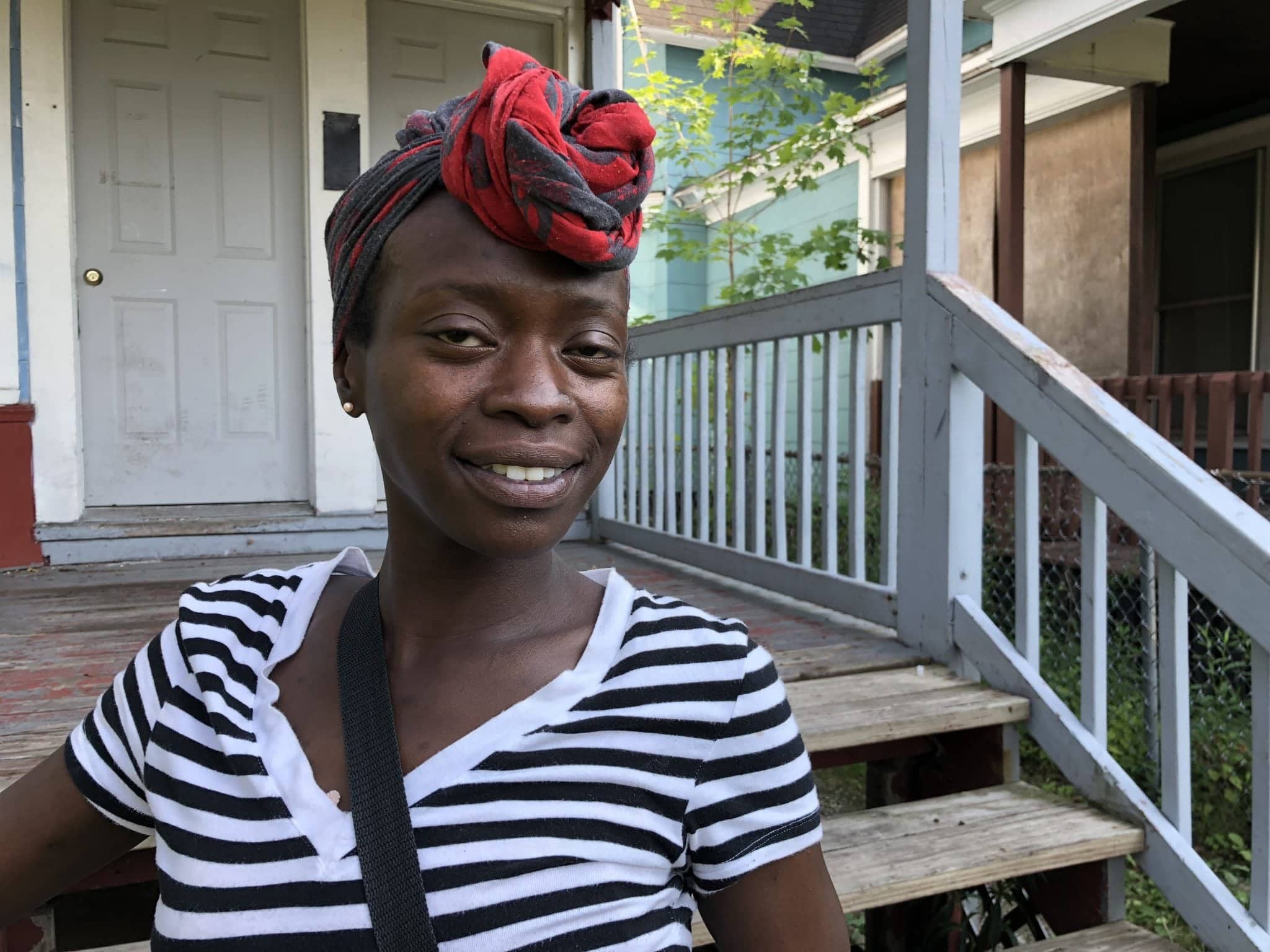Syringe exchange program aims to fight opioid addiction in Syracuse
Combating Syracuse opioid crisis through safe injection

Kristen Cerio stepped out of a van, wearing thick cargo pants and heavy sneakers. The temperature clocked in at just over 90 degrees before noon. Carrying two bright red containers and a trash picker to collect used hypodermic needles, Cerio moved slowly but deliberately to make sure she didn’t step on one.
“That’s the sign of a professional user,” Cerio said, pointing to the snapped-off metal tip of one of the nearly 200 needles she collected.
Snapping off the tips helps prevent accidental pokes or sharing used syringes. In the long-run, that means less disease transmission, she explained.
Cerio, 28, works as a caseworker for ACR Health’s Syringe Exchange Program (SEP).
This particular Monday afternoon was a scheduled needle cleanup for two abandoned homes on the Westside. Cleanups are part of a broader effort called “harm reduction,” or policies that aim to reduce the dangers associated with recreational drug use. Injection drug use is the highest risk factor for contracting hepatitis C (HCV).
The unkempt properties are joined by an alleyway leading to a shared backyard, barely separated by a battered chain link fence. Between the garbage and overgrown weeds, hundreds of neon orange syringe caps pepper the ground.
Last week’s cleanup netted over a thousand syringes. Today, about a quarter of that.
The house across the street is where users typically purchase heroin before hopping the fence to shoot up on the decrepit back porch, Cerio said. Some leave each other notes by scrawling in marker on a piece of plywood boarding one of the windows.
Rising HCV transmission rates are a consequence of New York’s opioid crisis, and since 2007, HCV-related deaths have outpaced HIV-related deaths outside of New York City, according to the state Department of Health. Last month, Gov. Andrew Cuomo announced the Hepatitis C Elimination Task Force to end HCV infection in New York State. Five million dollars has been allocated for the entire project. According to the announcement, the plan will incorporate a “spectrum of tools including safer use, managed use, and abstinence” to help users improve their situations in a realistic way.
Cuomo’s task force will provide a handful of designated “Drug User Health Hubs”—$100,000 each over a period of five years. This funding will allow organizations like ACR Health in Syracuse—one of the designated hubs—to expand patient navigation services and hire staff dedicated to increasing patient retention. It will also allow staff members at each facility to help secure insurance coverage for prescriptions or assist with coordinating patient transportation to their doctor appointments.
ACR Health is a non-profit organization providing health and social services to those affected by chronic diseases like hepatitis C. The syringe exchange program has three offices, located in Syracuse, Utica and Watertown.
Additionally, ACR Health provides a mobile outreach van that serves the Dudley and Fitch Street areas in Syracuse three afternoons a week. Cerio drives this van, bringing what she calls a “mobile office” into the most high-risk populations on the Westside. Users who visit the van can learn how to lower their risk of bloodborne illnesses by always using clean supplies and never sharing with others.
The mobile van provides injection drug users with sterile kits that include syringes, cotton balls, rubber tourniquets, alcohol pads and cookers—metal bottle caps without the threading—to prepare heroin for injection. The syringe exchange program staff also provides in-person instruction on safe injection to preserve long-term vein health.
“These services go beyond what the public may think of as traditional needle exchanges,” said program director Julia LaVere. “Just a clean needle isn’t good enough for hep C.”
LeVere described HCV as a “hardier” virus that’s able to survive for three weeks outside of the body, or as long as nine weeks in a syringe. This could potentially contaminate any of the items in a user’s injection kit and not just the syringe.
Belinda Felder is ACR’s SEP Coordinator. According to Felder, there’s no “one size fits all” approach to harm reduction given the different levels of awareness about injection risks. Because HCV can take upwards of a decade or longer to show symptoms, people in the thick of their addiction are often reluctant to seek treatment.
“When you’re getting high, you’re not really paying attention to your body singing to you,” Felder said. “It’s hard to get people off of drugs. I mean, if people could stop, they would.”
Felder also described the challenges of patient compliance and retention. Medications used to treat HCV have strict dosing requirements and can be prohibitively expensive for users that are poor or homeless. Felder said insurance companies are sometimes hesitant to cover costs for people who are still using drugs.
The average retail price at local pharmacies for an eight-week course of Gilead’s once-daily Harvoni is about $1,100 per pill. To be cured, patients must complete the entire treatment.
“The funds set aside by Gov. Cuomo’s task force can help mitigate some of those overwhelming challenges,” said ACR Health’s Director of Drug User Health, Alexandra Punch.
“People experience tons of barriers,” Punch said. “Sometimes it’s just about being a warm hand to walk them through the entire process so they don’t feel as scared and stigmatized.”
Three days after Kristen Cerio left behind the red needle container, it remained at the foot of the stairs. A smiling woman with her head wrapped in a scarf perched on the rotting porch, washing her arms with hand sanitizer.

Phyllis Gary, or “Philly” authored one of the plywood notes. She recently reconnected with Miranda, she said, smiling. Tucking away her sanitizer, Gary acknowledged the collection box nearby. A nurse in her old life, she understands why safe injecting is so important.
“There’s normally a lot more needles,” Gary said, “but the red box, that box really helps cut it down.”





